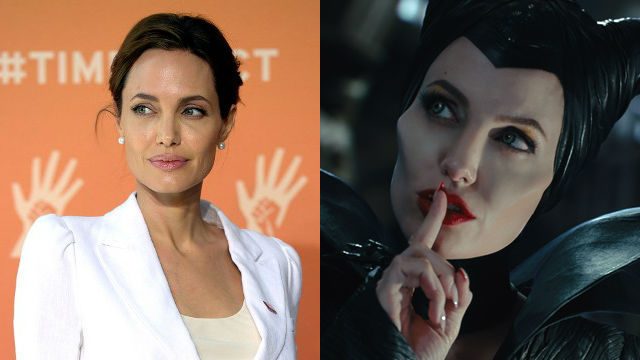SUMMARY
This is AI generated summarization, which may have errors. For context, always refer to the full article.

LONDON, United Kingdom – There was something strangely disturbing about Maleficent.
The blockbuster Disney hit is a “reinvention” of Sleeping Beauty, but in the hands of 2 strong women, writer Linda Woolverton and Oscar-winning actress Angelina Jolie, it became a feminist re-telling of the classic tale.
It begins with identity: Maleficent, played by Jolie, is not a witch, but a winged fairy who protects her magical kingdom.
“The biggest surprise is that she’s a fairy, not a witch,” Woolverton, whose credits include Beauty and the Beast, The Lion King, and Alice in Wonderland, told The Hollywood Reporter. “I’ve always wanted to do a dark fairy story. Then I watched that scene where she curses the baby, and I’m thinking ‘well, if she’s a fairy, where are her wings?’ Suddenly, it was ‘boom. Lightbulb. Oh! It’s the wings!’ Then I worked backward from there to create the Stefan relationship.”
Stefan was a young boy who ventured into the land of the fairies. He’s cornered by magical creatures angry at him and is rescued by the young Maleficent.
The two become friends and fall in love. Stefan goes back to his human world, grows up to become an ambitious young man. Wanting more power, he courts the favor of the king, who orders Stefan to kill Maleficent.
He goes to the edge of the fairy kingdom and lulls a grown Maleficent out of safety. They spend the night together. He drugs her to sleep and pulls out a knife – but he cannot kill the magical creature.
Instead, he hacks off her wings.
That scene added depth and an allusion to rape, which 39-year-old Jolie admitted was precisely the point she and Woolverton wanted to make.
“We were all very conscious of it,” Jolie told London’s Evening Standard. “It was, in fact, rape. It was clear.”
For the first time, Jolie discussed Maleficent and rape on the sidelines of a 4-day Global Summit to End Sexual Violence in Conflict in London.
“That was a metaphor for rape,” Jolie said. “The core of Maleficent is abuse and how the abused have a choice of abusing others or overcoming and remaining loving, open people.”
Maleficent takes revenge after Stefan becomes king and has a daughter named Aurora. At her christening, Maleficent, now all in black, sweeps into the hall and curses the baby: ‘Before the sun sets on her sixteenth birthday, she will fall into a sleep-like death!”
“What could make a woman so dark?” asked Jolie. “To lose all sense of her maternity, her womanhood, and her softness? Something would have to be so violently aggressive.”
“The biggest challenge was how to make a villain into a protagonist,” Woolverton said. “How on earth was I going to justify that this woman would curse a baby?”
“She was with a man. She is violated,” Jolie explained. “Of course, it’s a Disney story, but she goes through a period of losing herself and her femininity and her motherly qualities.”
Stories of rape and its impact on victims and their societies were told at the summit in London, co-chaired by Jolie with Britain’s Foreign Secretary William Hague. Their goal: practical action to stop the systematic sexual violence in conflict; to help prosecute those who carry out these crimes; and to help survivors cope.
It’s fitting Jolie reveals how her real-life obsession – to end sexual violence in conflict – is mirrored in her latest artistic endeavor.
What saves Maleficent?
Her growing love of the child, Aurora.
And that’s the final, feminist twist to Sleeping Beauty: instead of the Prince kissing Sleeping Beauty awake from her death-like sleep, “true-love’s kiss” comes from her mother figure, Maleficent.
Through the years, Maleficent begins to love the child she watches over silently, at one point, rescuing her from what could be a fatal fall off a cliff.
Continuing the allegory of rape, Maleficent lashes out with the curse, which over time, she tries to undo but can’t – like victims who lash out in anger – anger that always brings consequences.
When the curse is triggered, Maleficent finds the Prince and brings him to Aurora. He kisses her with no effect.
Despairing, Maleficent kisses Aurora on her forehead, and the curse is broken.
True love’s kiss … is the kiss of a mother.
Woolverton says that was the most important scene – “one of the more emotional experiences of her professional career.”
“What’s done is done,” Woolverton says about Maleficent’s curse. “She doesn’t ask for forgiveness, and her love for Aurora is her redemption.”
– Rappler.com
Related stories:
- Ending warzone rape: A cause for our generation
- Two Filipinas represent PH in London global summit
- Angelina Jolie co-hosts London summit vs sexual violence in conflict
- Jolie: We can end use of rape as weapon of violence
- Jolie, Hague mobilize global action vs rape in war
- Jolie and Hague launch International Protocol for sexual violence
- Brad Pitt adds support to Jolie at warzone rape meeting
- AS IT HAPPENS: Summit to end sexual violence: Ministers’ Day
- AS IT HAPPENS: Summit to end sexual violence: Closing plenary
- Nigerian schoolgirls ‘a heinous example of sexual violence’
- #TimeToAct Hangout: End Sexual Violence in Conflict
- Angelina Jolie, warzone rape, and the celebrity effect
- Banish sexual violence ‘to dark ages’ – Kerry
- Britain makes Angelina Jolie an honorary dame
- Kerry, Hague, Jolie on Iraq and wartime rape
- The passion of Angelina Jolie
Add a comment
How does this make you feel?





There are no comments yet. Add your comment to start the conversation.